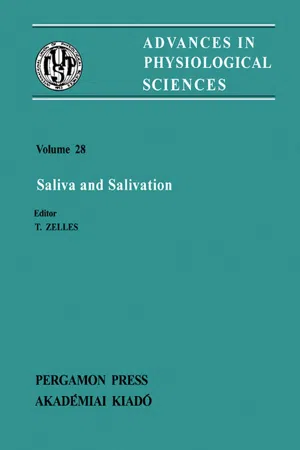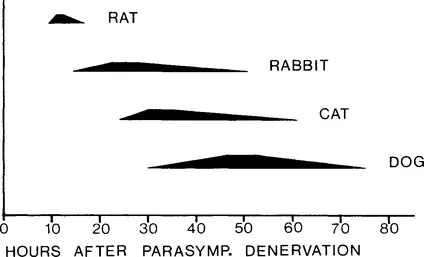
Saliva and Salivation
Satellite Symposium of the 28th International Congress of Physiological Sciences, Székesfehérvár, Hungary, 1980
- 380 pages
- English
- ePUB (mobile friendly)
- Available on iOS & Android
Saliva and Salivation
Satellite Symposium of the 28th International Congress of Physiological Sciences, Székesfehérvár, Hungary, 1980
About This Book
Advances in Physiological Sciences, Volume 28: Saliva and Salivation covers the proceedings of the Saliva and Salivation satellite symposium, which is a pre-congress meeting connected to the 28th International Congress of Physiological Sciences. The book discusses a wide variety of studies that are relevant to the function of salivary system. This variety includes denervation as a method to produce a prolonged stimulation of salivary glands and reflex activation of the preganglionic fibers innervating the submandibular gland. This text also explains reflex discharge recorded from rat submandibular ganglion cells in vivo and effects of acetylcholine and adrenergic agonist on potassium transport in the salivary glands in vitro. This monograph will be of great interest to professionals and researchers, including dentists and zoologists, whose work concerns oral physiology.
Frequently asked questions
Information
DENERVATION AS A METHOD TO PRODUCE A PROLONGED STIMULATION OF SALIVARY GLANDS
Publisher Summary


1 Control of the chemo-sensitivity of salivary glands
Table of contents
- Cover image
- Title page
- Table of Contents
- ADVANCES IN PHYSIOLOGICAL SCIENCES
- Copyright
- PREFACE
- INTRODUCTION
- IMPRESSIONS on the Saliva and Salivation Symposium (Székesfehérvár, 10–12 July, 1980)
- Chapter 1: DENERVATION AS A METHOD TO PRODUCE A PROLONGED STIMULATION OF SALIVARY GLANDS
- Chapter 2: REFLEX ACTIVATION OF THE PREGANGLIONIC FIBERS INNERVATING THE SUBMANDIBULAR GLAND
- Chapter 3: REFLEX DISCHARGES RECORDED FROM RAT SUBMANDIBULAR GANGLION CELLS IN VIVO
- Chapter 4: EFFECTS OF ACETYLCHOLINE AND ADRENERGIC AGONISTS ON POTASSIUM TRANSPORT IN THE SALIVARY GLANDS IN VITRO
- Chapter 5: ELECTROLYTE CONTENT OF PRIMARY AND FINAL SALIVA OF RABBIT MANDIBULAR GLANDS STUDIED IN VIVO
- Chapter 6: SECRETORY PROCESSES IN THE PERFUSED RABBIT MANDIBULAR GLAND
- Chapter 7: PHYSALAEMIN ACTION ON SALIVARY ELECTROLYTE TRANSPORT
- Chapter 8: DIRECT AND MODULATING SECRETORY EFFECTS OF SUBSTANCE P ON RAT SUBMANDIBULAR GLAND
- Chapter 9: RECEPTOR MECHANISMS INVOLVED IN STIMULUS-SECRETION COUPLING IN SALIVARY ACINAR CELLS
- Chapter 10: SOLUTION OF EPITHELIAL CELL MODELS FOR SECRETION AND ABSORPTION USING OPTIMIZATION ROUTINES
- Chapter 11: RELATIONSHIPS BETWEEN MINERALOCORTICOIDS AND Na+-K+-ATPase IN RAT SUBMANDIBULAR GLAND
- Chapter 12: THE ENERGETICS OF FLUID AND ELECTROLYTE SECRETION
- Chapter 13: SYNTHESIS, STORAGE, METABOLISM, RELEASE AND FUNCTION OF HISTAMINE IN THE CAT SUBMANDIBULAR GLAND
- Chapter 14: BLOOD FLOW IN THE SALIVARY GLANDS OF THE RAT
- Chapter 15: PERMEABILITY OF SALIVARY GLANDS TO MACROMOLECULES
- Chapter 16: VASCULARIZATION OF THE DEVELOPING RAT SUBMANDIBULAR GLAND
- Chapter 17: ULTRASTRUCTURAL SIGNS OF THE EARLY SALIVARY SECRETION IN CONNECTION WITH THE NERVE DEVELOPMENT IN THE RAT
- Chapter 18: HISTOCHEMICAL CHARACTERIZATION OF SALIVARY GLAND SECRETION
- Chapter 19: MORPHOLOGICAL CHANGES OF ACINAR CELLS IN THE SUBMANDIBULAR GLANDS OF MICE AFTER STIMULATION WITH AUTONOMIC DRUGS
- Chapter 20: MORPHOLOGY OF SECRETING SEROUS AND MUCOUS SUBLINGUAL GLAND CELLS OF THE MOUSE
- Chapter 21: QUANTITATIVE ULTRASTRUCTURAL CHANGES IN RAT PAROTID ACINAR CELLS AFTER LONG-TERM TREATMENT WITH SELECTIVE β-ANDRENOCEPTOR AGONISTS
- Chapter 22: DENSITY DISTRIBUTION OF THE SECRETORY GRANULES IN THE RAT PAROTID GLAND
- Chapter 23: PREPARATION OF ZYMOGEN GRANULES WITH GEL FILTRATION: DISTRIBUTION OF AMYLASE AND CARBONIC ANHYDRASE ACTIVITY FOLLOWING “LINEAR-DISCRETE” DENSITY GRADIENT CENTRIFUGATION
- Chapter 24: OSMOTIC PRESSURE AS A PRESUMABLE FACTOR INFLUENCING THE ZYMOGEN GRANULES IN THE PAROTID GLAND OF RATS
- Chapter 25: CONVERSION OF β-N-ACETYLHEXOSAMINIDASE B TO A BY GOLGI COMPLEX OF RAT PAROTID GLAND
- Chapter 26: CHARACTERISTICS OF SALIVARY α-AMYLASE OF THE MOUSE
- Chapter 27: INTERACTION OF CA2+ AND ADENOSINE 3′,5′-CYCLIC MONOPHOSPHATE DURING STIMULATION OF AMYLASE SECRETION FROM THE RAT PAROTID GLAND BY β-ADRENERGIC AGONISTS
- Chapter 28: AMYLASE SECRETION AND CYCLIC AMP-DEPENDENT PROTEIN PHOSPHORYLATION
- Chapter 29: CHANGES IN RAT PAROTID GLAND AMYLASE SECRETION AND cAMP LEVELS UNDER VARIED CONDITIONS OF β-ADRENOCEPTOR ACTIVITY
- Chapter 30: EFFECTS OF SUBSTANCE P RELATED PEPTIDES ON THE AMYLASE SECRETION IN RAT SALIVARY GLANDS
- Chapter 31: SALIVARY SECRETION OF FLUID AND AMYLASE IN THE PAROTID GLAND OF THE RABBIT AND THEIR DEPENDENCE ON TASTE AND CHEWING
- Chapter 32: REGULATION OF SUBLINGUAL (GLYCO)PROTEIN SECRETION IN THE MOUSE
- Chapter 33: NEURALLY REGULATED CHANGES IN ELECTROLYTE AND PROTEIN LEVELS OF RAT SALIVARY GLANDS DURING POSTNATAL DEVELOPMENT
- Chapter 34: AMYLASE SYNTHESIS IN THE PAROTID GLAND OF CORTISONE-TREATED RATS
- Chapter 35: EFFECT OF ESSENTIAL FATTY ACID DEFICIENCY ON ACYL GROUP COMPOSITION OF PLASMA MEMBRANES AND (Na+-K+)ATPase ACTIVITY OF SUBMANDIBULAR SALIVARY GLANDS IN RATS
- Chapter 36: CROSSED IMMUNOELECTROPHORETIC METHODS OF SEPARATION OF SALIVARY PROTEINS AT PHYSIOLOGICAL CONCENTRATIONS
- Chapter 37: GENETIC POLYMORPHISMS OF HUMAN PAROTID SALIVARY PROTEINS AND SALIVARY AMYLASE ISOZYME IN JAPANESE POPULATION
- Chapter 38: CHEMISTRY OF SALIVARY GLAND HORMONE
- Chapter 39: A MODEL FOR SALIVA-MEDIATED BACTERIAL AGGREGATION
- Chapter 40: FACTORS INVOLVED IN THE ADHERENCE OF SALIVARY PROTEINS TO HYDROXYAPATITE
- Chapter 41: THE SECRETION OF IONISED AND TOTAL CALCIUM, PROTEIN AND INORGANIC PHOSPHATE BY THE SALIVARY GLANDS OF RAT AND MAN
- Chapter 42: THE EFFECT OF PTH ON HUMAN PAROTID AND SUBMANDIBULAR SALIVA
- Chapter 43: EFFECTS OF PHYSIOLOGICAL VARIABLES ON THE CONCENTRATION OF CORTISOL IN HUMAN SALIVA
- Chapter 44: MANAGEMENT OF HEAD AND NECK IRRADIATED PATIENTS
- Chapter 45: PAROTID FLUID COMPOSITION IN HEALTHY AGING MALES
- Chapter 46: CHEMICAL COMPOSITION OF PAROTID SALIVA IN SJÖGREN’S SYNDROME
- Chapter 47: POSSIBLE ROLE OF PAROTID ADRENERGIC BETA-RECEPTORS IN SIALADENOSIS
- Chapter 48: SALIVA AND TASTE DISORDERS
- Chapter 49: THE ACTIVITY OF SOME SALIVARY ENZYMES OF THE RAT FED WITH A CARIOGENIC DIET AND WITH FLUORIDATION OF THE DRINKING WATER
- Chapter 50: HISTOPATHOLOGICAL STUDIES ON MESENCHYMAL TISSUES OF RAT TREATED WITH EXTRACTS FROM PAROTID GLANDS
- INDEX